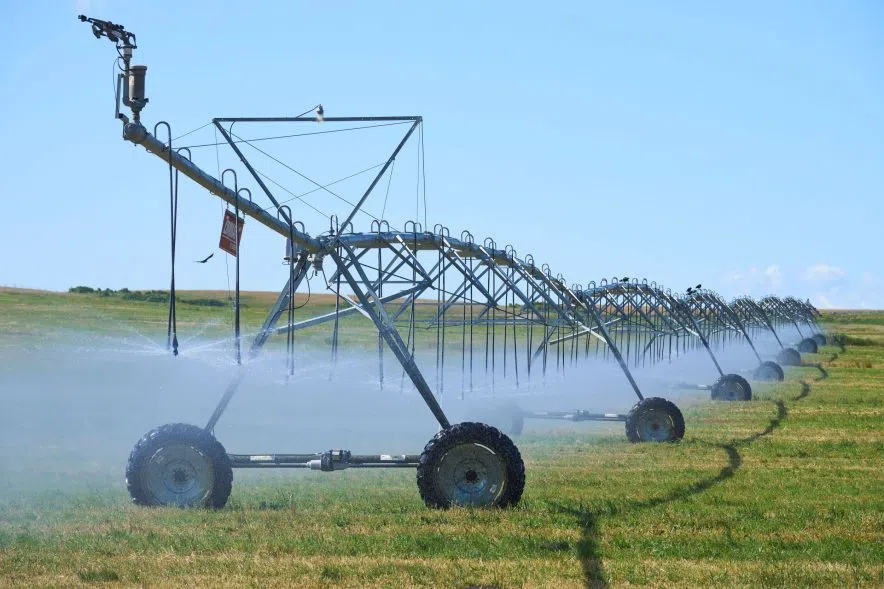One month after the Saskatchewan Association of Rural Municipalities (SARM) demanded progress on the Lake Diefenbaker irrigation project, the provincial government is set to deliver.
On Thursday, Premier Scott Moe announced at SARM’s annual convention in Regina that the province will be moving ahead with what the government called “the early works” of the first 90,000 acres of the project.
“Our government is happy to take the first major step in creating the most sustainable food and economic security project in Canada which will create major benefits for generations,” Moe said in a release.
“Saskatchewan can be a leader across the country and move this project forward which will provide billions in economic benefits and thousands of jobs.”
In July of 2020, the Saskatchewan government gave the green light to the project, which was to irrigate up to 500,000 acres of land from Lake Diefenbaker. The project is to more than double the irrigable land in Saskatchewan.
The government said the engineering and design of the project — as well as engagement with stakeholders and Indigenous rights holders — is expected to be done over the next year or 14 months. Major construction on the 90,000 acres is being targeted for 2025.
The government said the estimated cost of $1.15 billion will be shared between the province and producers who choose to participate.
“As producers come online, we’ll be able to have a formula ready so that they can participate and they will share in part of the program,” Moe told reporters after his speech.
Lake Diefenbaker was built in 1967 by the provincial and federal governments to supply water for people, industry, power production, flood control and irrigation.
Moe said the lake hasn’t been used to its full potential, and he hopes Ottawa can come on board to help fund the expansion.
“Decades ago, Lake Diefenbaker was built with the specific intention to increase irrigation in this province, and until now I’d say that dream has not been fully realized,” he said. “We cannot wait for the federal government. We’re going to move forward on our own.”
The project is the first phase in a series to expand the use of water from the lake.
In 2020, Moe had announced the entire project would cost about $4 billion. He said he expects those costs to be much higher now, and it will move forward in a phased approach.
“It’ll literally be acre by acre,” he said.
Some First Nations and environmental groups have raised concerns more irrigation could negatively affect wildlife if water is moved out of critical areas.
Climate scientists have said Saskatchewan’s summers are expected to get hotter and drier as the climate changes, with water becoming a more valuable resource.
“Ultimately, at the end of the day, what the project will provide is not only water security for a higher value agricultural production, but water security for a number of communities,” Moe said.
SARM president Ray Orb previously said the federal government was stalling progress on the project.
Patrick Boyle of the Water Security Agency said earlier the agency has twice applied to the federal government’s Disaster Mitigation Adaptation Fund for financial support, but its first application was denied and the agency is currently awaiting a response for the second.
SARM has been pushing for the project to start because of the dry years the province has gone through.
“Today marks an important point in our history for rural municipalities,” Orb said in Thursday’s release. “SARM applauds the provincial government for moving this project ahead and ensuring future generations of rural residents will experience the benefits. This is the start of a journey to bring Saskatchewan and Canada much-needed food and economic security.”
Phase 1 of the project, which is expected to cost $500 million, will include the rehabilitation and expansion of the existing Westside irrigation canal system. That’s expected to increase the amount of irrigable land in the area by 80,000 acres.
The second and third phases are to cost up to $3.5 billion.
Phase 2 will involve further expansion and buildout of the Westside Irrigation Project, a move that will add another 260,000 acres of irrigable land. That includes areas near Macrorie, Milden and Zealandia, and as far north as Delisle and Asquith.
The third phase will feature the buildout of the Qu’Appelle South Irrigation Project, which would add about 120,000 more acres of irrigable land.
Starting at Lake Diefenbaker and going south, the project would run near Tugaske and Eyebrow, down to Marquis and into Buffalo Pound Lake.
— With files from The Canadian Press











